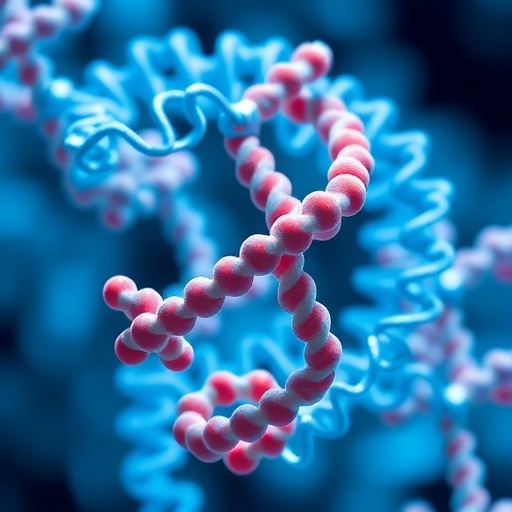In the relentless pursuit of advancing precision medicine, predicting the complex interactions between multiple drugs remains a formidable challenge. A groundbreaking approach recently detailed in Advanced Science pivots on integrating protein three-dimensional spatial structures with cutting-edge artificial intelligence (AI) techniques. This innovative fusion holds the promise of transforming how clinicians and researchers anticipate synergistic or antagonistic drug effects, ultimately guiding personalized and safer therapeutic regimens.
Proteins, the molecular machines at the core of biological processes, exhibit intricate three-dimensional conformations that profoundly influence drug binding and efficacy. The review published on August 7, 2025, emphasizes the critical role of spatial protein architecture—encompassing shape, size, and the dynamic flexibility of binding sites—in dictating how individual drugs, and more importantly, combinations of drugs, interact with their molecular targets. Alterations in protein conformation can substantially modulate how drugs synergize or counteract each other, thereby impacting treatment outcomes.
Traditional drug combination studies often suffer from a lack of granularity, focusing predominantly on empirical or phenotypic outcomes. By contrast, harnessing precise protein structure data enriches our understanding at the molecular level, enabling a mechanistic dissection of drug interactions. Advanced structural biology techniques, including cryo-electron microscopy and X-ray crystallography, now provide increasingly resolved protein models. These insights are crucial for mapping potential binding mechanisms and allosteric modulations that influence drug synergy or antagonism.
The integration of AI—particularly machine learning and deep learning algorithms—with protein structural data represents a significant leap forward. These computational methodologies excel at parsing vast, complex datasets, uncovering hidden patterns that elude traditional analysis. Through training on multidimensional data derived from structural biology, genomics, and pharmacology, AI models can simulate and predict how various drug molecules might interact with one or multiple protein targets under different physiological conditions.
One particularly compelling aspect highlighted in the review is AI’s capacity to simulate conformational changes of proteins induced by drug binding. By factoring in the dynamic nature of protein folding and flexibility, predictive models can anticipate how slight alterations affect drug efficacy and potential adverse interactions. This dynamic modeling is paramount for understanding multi-drug regimens, where conformational shifts might amplify beneficial synergistic effects or inadvertently promote antagonistic interactions.
Moreover, AI-driven analyses facilitate the prediction of patient-specific reactions to drug combinations by incorporating genomic and proteomic data. This personalized approach aligns with the broader vision of precision medicine, tailoring therapeutic strategies not only to the molecular architecture of targets but also to individual genetic and epigenetic profiles. Such a confluence of data-driven insights promises to mitigate drug resistance, a critical hurdle in oncology and chronic disease management, by designing combination therapies optimized for maximal therapeutic benefit.
The practical applications of this interdisciplinary approach are manifold. High-throughput screening experiments provide vast datasets of potential compound combinations, which AI algorithms refine by accurately modeling protein-drug interactions. Coupled with clinical data streams, this approach accelerates the identification of drug combinations that demonstrate enhanced efficacy and reduced toxicity, thereby shortening drug development timelines and improving patient safety.
Importantly, modular computational frameworks that can seamlessly integrate new protein structures and pharmacological data are being developed. This flexibility ensures that as new protein structures are resolved or as drug libraries expand, AI models can be updated dynamically, maintaining their predictive accuracy and relevance. Such adaptability is crucial given the rapid pace of discovery in both structural biology and artificial intelligence.
The review also underscores the transformative potential of this synergy in overcoming drug resistance. Resistance often arises from mutations that perturb the binding sites or conformations of targeted proteins, rendering mono-therapeutic drugs ineffective. AI-assisted modeling of such mutated proteins allows for the rational design of multi-target drug combinations that preempt or circumvent resistance mechanisms. This strategy could revolutionize treatment paradigms, particularly in oncology where resistance remains a significant therapeutic barrier.
Additionally, reducing side effects through optimized drug combinations has profound clinical significance. By predicting antagonistic interactions at the molecular level, AI models can help avoid combinations that may lead to adverse reactions, enhancing patient adherence and quality of life. Such predictive safety assessments, grounded in structural biology, complement existing toxicological studies and hold promise for more rational prescription practices.
From an academic and industrial perspective, this interdisciplinary framework fosters collaboration across computational biology, structural pharmacology, and clinical medicine. The effective translation of AI-augmented structural insights into clinical practice requires a multidisciplinary effort, combining expertise in algorithm development, high-resolution protein imaging, and patient-centric data analytics.
In sum, the convergence of protein three-dimensional structural data with artificial intelligence heralds a new era in drug combination therapy. The approach outlined offers an unprecedented granular understanding of molecular interactions, empowers personalized therapeutic strategies, and accelerates drug discovery processes. As more comprehensive structural datasets and AI models become available, this paradigm is poised to significantly impact the future landscape of precision medicine.
By revolutionizing our capacity to predict and rationalize drug synergy and antagonism, this innovative strategy aligns closely with the overarching goals of modern healthcare: safer, more effective treatments designed with molecular precision tailored to individual patients. The integration of structural biology and AI thus represents not only a technological advance but a necessary evolution in tackling the complexity of polypharmacy in contemporary medicine.
—
Subject of Research: Protein three-dimensional spatial structure and artificial intelligence integration for drug synergy and antagonism prediction
Article Title: Protein Spatial Structure Meets Artificial Intelligence: Revolutionizing Drug Synergy–Antagonism in Precision Medicine
News Publication Date: August 7, 2025
Web References: 10.1002/advs.202507764
Image Credits: Adapted from Lin et al., Advanced Science (2025)
Keywords: Artificial intelligence, Cancer




